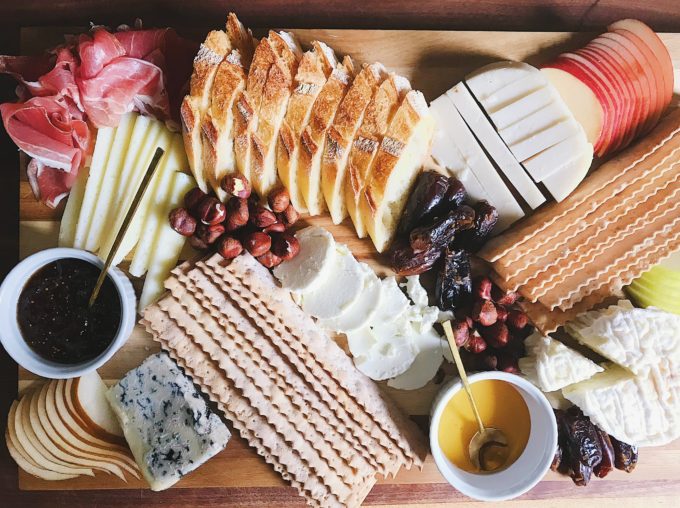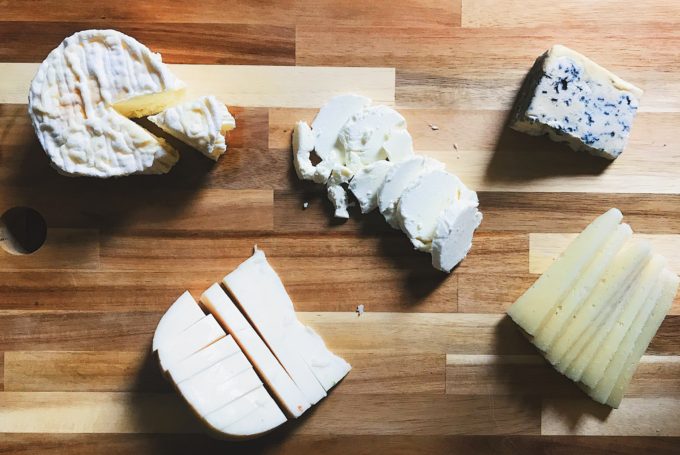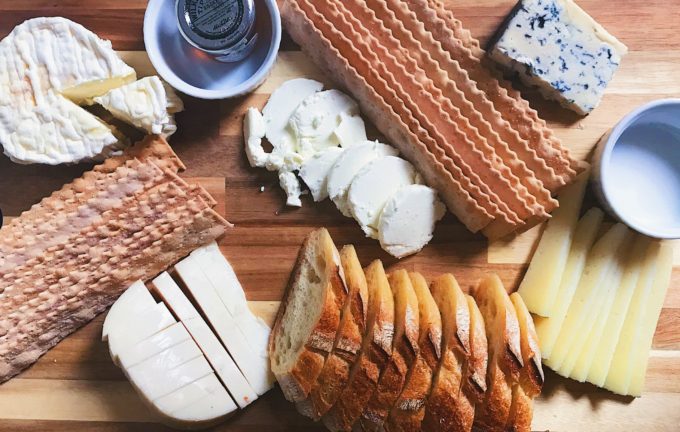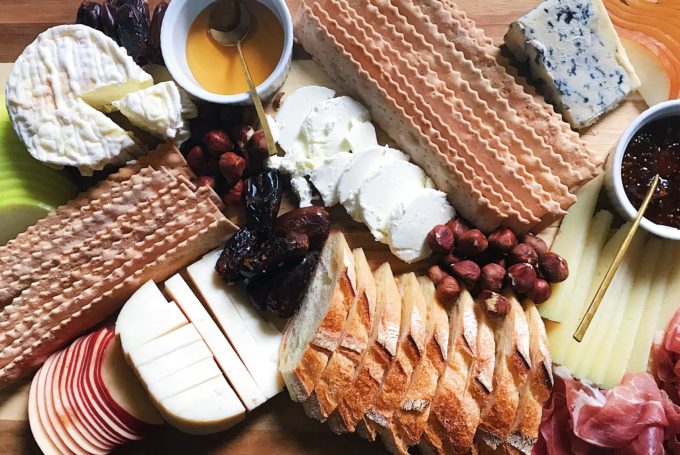
The holiday season is upon us, my friends. This is a stressful time of year for everyone, especially if you have the task of hosting. Skip the crock pot meatballs and elevate your hors d’oeuvres game with a fancier finger food: cheese. Don’t get me wrong, I love a good chip, dip, and sip combo but hear me out. If you make a cheese board ahead of time, you have time to do literally everything else that’s stressing you out, like lighting candles, or making sure that Michael Buble Spotify playlist fits the mood. SO. Use these tips on how to make a cheese board and your friends are going to think you’re very smart and impressive. Welcome to Cheese Class 101.
Some general rules for making a cheese plate:
- Try different textural variety
- Use different milk cheese
- Recognize the country of origin and region

Cheese Categories by Texture
Soft Cheese: Not aged for more than a month. Very soft like goat’s milk Chevre, Mozzarella, Ricotta.
Soft Ripened: Has been sprayed with bacteria to allow mold to create rind. Brie, Camembert, La Tur.
Soft Wash Rind: Washed with brine, beer, cider, wine, brandy, or oils while ripening. Promotes bacterial growth to to ripen from outside in. Generally has a pungent smell. Think Taleggio, Epoisses.
Semi-Soft and Medium Hard: Ripened in several ways. Some are sealed in wax, like Gouda, before aging. Fontina, Havarti, Gouda.
Blue Veined: Needles are used to form holes inside of the cheese and introduce mold. This process helps gasses escape and oxygen to enter, creating a vein pattern. Often ripened in caves or cave-like environments. Think Roquefort, Gorgonzola, Stilton Blue.
Hard Cheese: Low moisture content. Cheddar, Swiss, Manchego, Gruyere. Cheddar is cheese curds wrapped in cheesecloth and all the whey has been extracted. Usually aged 30 days for mild and 9mo-5yr for extra sharp.
Very Hard Cheese. Parmesan-Reggiano, Pecorino Romano, Asiago. Produced in large wheels. Often grated or shaved, broken off into chunks. Aged generally around 14 months.

Source of Milk
Cow and water buffalo, goat, sheep, or blends. I’ve even eaten camel’s milk cheese in Morocco.
Region
Things pair best regionally. Ie Italian cheese goes well with Italian wine and charcuterie. These things all grow together, thus taste best together.

Steps for building
Pick your plate
Something large enough to hold everything you’re putting on there! You don’t want people to have to dig through to get a piece. If you don’t have something large, use dinner plates and create flavor combinations like goat cheese, honey, and walnuts with rosemary crackers that you want your guests to eat together.
Pick your cheese
Choose different textures, ages, milks, and regions. I go for one soft and spreadable like Chevre (goat), one semi-soft like a creamy blue (generally, cow or sheep), something in a soft, bloomy rind like La Tur (a blend of cow, goat, and sheep), a medium hard cheese like Gouda (goat or cow) and a hard cheese like Manchego (aged sheep). This way, your guests have a variety of textures and flavors to try.

Cut for your guests
The board shouldn’t be a mess from your guests struggling to get a piece of cheese. You also don’t want it to look like Game of Thrones with knives sticking out of each cheese. I hate this look. When in doubt, ask your cheesemonger when purchasing how each cheese should be sliced. Some cheese I DO leave whole on the board because the texture gets ruined if you slice it ahead of time, like a really creamy blue. I’m not a big fan of cheese cubes either. Instead, cut your cheddar or gouda thin and length wise, not larger than two bites. See picture above.

Place condiments next to the cheese you want it eaten with
Create pairings for your guests. You should choose condiments that compliment your cheese like honey, fig or quince jam, whole grain mustard. These items are there to help bring out other flavors in the cheese, not to mask the flavor. Don’t cover your beautiful selection of cheese in condiments! Just leave them in ramekins next to what you want your guest to eat it with.

Choose seasonal accompaniments
We’re in the beginning of fall right now so markets are abundant with apples and pears. Some stonefruit is still around and is lovely in jam form. You want to choose some seasonal fruit to hang out with your cheese. Don’t just buy grapes or strawberries and plop them on there. In fact, I prefer dried fruit like apricots to grapes with cheese unless you have some really amazing seasonal grapes. Drink the grapes! What goes better with cheese than wine?
Grab some gluten
Choose a mild cracker like olive oil and sea salt and just a plain French baguette. This way, the bread isn’t the star of the show, but a vehicle to get the cheese into your mouth.

How to build
Now we have our board, our cheese, condiments, accompaniments, and bread. Let’s build!
- Cut the cheese (hehe) on a different cutting board so you don’t make a mess on your presentation board. With soft cheese, make sure to wipe your knife between each cut to keep it looking clean.
- Place each cheese apart from one another on your board. We used La Tur cheese which is very soft and runny, so I want the guest to cut it themselves. I have cut the first slice to use as an example for my guests of how this cheese should be sliced. It’s okay if they don’t get it and cut it differently! It’s a party, remember?
- Next add ramekins for condiments.
- At this point I like to place bread and crackers on the board because they take up a lot of space. Another option is to place them on a different plate or platter if your board isn’t so big.
- Now, I like to add fruit close to the cheese they pair well with. If you’re adding charcuterie, add it here.
- Fill in blank spaces with dried fruit and nuts, also keeping in mind which cheese they go best with.
- Lastly, just add spoons in your condiments and a good cheese knife near the cheese you want guests to cut themselves.

Beautiful! Thank you Annie!
This is awesome. And so needed. Thank you Annie. Cut the cheese😜
Love all the ideas. I never know if I should slice the cheese. Great ideas on how to organize all
Together.
Love this advice on creating tasty, beautiful cheese boards. Thank you!